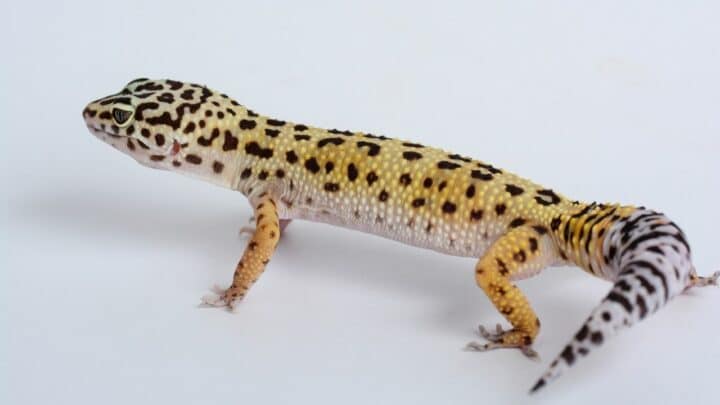Leopard geckos are adorable little creatures.
They’re relatively small, friendly, easy to care for, as long as you know the general guidelines for keeping them alive and thriving, and they are one of the most low-maintenance reptiles you can own.
With that said, just because they don’t need the perfect environment to stay happy doesn’t mean they don’t have the occasional health issue.
If your leopard gecko has a toe that looks blackish-purple and you’re wondering what is going on, take solace that you’re not alone.
Leopard Geckos Toe Looks Blackish Purple — What is Going On?
Toes appearing blackish-purple in a leopard gecko has something to do with lack of circulation due to a shedding issue. The shedding itself is nothing to worry about, but you may see the toes change color when the skin gets stuck and cuts off the blood supply.
The Leopard Gecko Shedding Process
Like all reptiles, leopard geckos like to ditch their skin. Adults shed every four to six weeks, with babies and juveniles shedding faster to match their growth rate.
While shedding is entirely normal, stuck skin is not and can cause a lack of blood flow to the affected area.
When the feet or toes don’t have blood flow, your gecko will suffer from lack of circulation, causing the black or purple toes, which are a hallmark sign of lack of blood in the area.
For the most part, you can fix this issue quickly by soaking your gecko in a warm (not hot) water bath for around ten minutes.
You may need to soak your gecko more than once to loosen up the dead skin that’s causing the problem. When the skin is wet, it’s easier for your gecko to run against the rocks and enrichment items in its tank to remove the skin.
When the situation is dire, you can soak your gecko and gently remove the skin yourself. Like any living thing, geckos cannot go too long without circulation.
Waiting too long to remove dead skin can cause the loss of an extremity or limb.
If you’ve soaked your gecko, and neither you nor the gecko can remove the stuck skin, take it to your veterinarian. A vet has the necessary tools to help your gecko along in the shedding process.
It’s imperative to remain gentle when removing stuck skin, as it’s not as hard as you think to pull off a gecko’s toe accidentally. If you’re not confident in your abilities, a professional is your best bet!
Geckos have to shed. It’s part of their existence.
You can provide a moist hide for them to help them along with their shedding as well! When you notice that your gecko has begun to shed, ensure that you keep an eye on them for an instance of stuck skin.
Other Potential Problems with a Purplish-Black Toe in Leopard Geckos
Not every gecko with a black or purple toe has stuck skin, though this is the most common reason for poor circulation.
Since there’s always a chance that something else is going on, if you’ve tried soaking your gecko and can’t release the skin, or if you don’t notice any stuck skin, take your gecko to the vet.
If you’re unsure what is going on, best seek your vet’s help. After all, you don’t want to make any incorrect guesses and put your gecko in danger.
While looking after such a small animal can be potentially overwhelming, stick with the idea that it’s best to ask if you don’t know. Geckos can get hurt and bruised while playing or exploring in their enclosure.
Occasional injury is part of life! However, the more prepared you are to deal with such injuries, the happier you’ll be with your leopard gecko.
Frequently Asked Questions about Leopard Geckos Toes Look Blackish Purple
What’s causing my leopard gecko’s toes to turn black?
If you notice a change in color of your leopard gecko’s toe or toes, you’ll want to carefully remove him from his tank and take a closer look. If you see stuck skin, you can go from there, but take your gecko to the vet if the problem is unexplained.
Could my gecko lose toes?
If the issue remains unaddressed, then it’s not unheard of to say that your leopard gecko could lose toes from a lack of circulation. Blood flow is imperative for healthy extremities, and once a gecko loses a toe, it won’t grow back, unlike its tail.
How can I make shedding easier on my gecko?
Try providing your gecko with a moist hide by putting a damp paper towel or coconut husk in one of its favorite hiding spots, especially if the humidity in its tank is low. The consistent dampness will help your leopard geck shed without problems.
Keeping Your Gecko Healthy
Leopard geckos are easy to care for no matter what stage of the life cycle they’re in. As long as you take the necessary steps to keep them healthy, there’s nothing you should worry about.
A clean tank, relatively low humidity, warmth, places to hide and climb, a moist hide, and their favorite diet of mealworms or crickets is an excellent start to a leopard gecko with a long lifespan!


